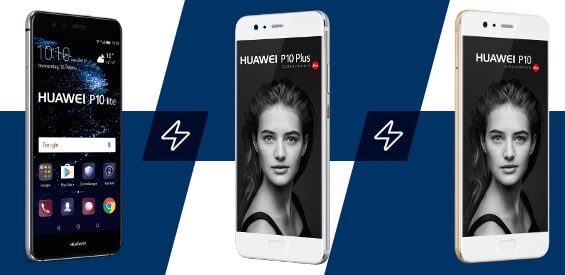From now on, the P10 family from Huawei consists of three models. In addition to the flagships P10 and P10 Plus, which were presented at the Mobile World Congress in Barcelona at the end of February, the P10 lite will also be available from the end of March. And lite here means that a significantly slimmed-down variant is offered. The editorial team of inside-digital.de shows how the three P10 models differ from each other.

Table of Contents
1 operating system
2 processing
3 Display
4 performance
5 Cameras
6 LTE and WiFi
7 IP certification
8 storage space
9 price
10 conclusion
The basic message when comparing the Huawei P10 , P10 Plus and P10 lite is: If you pay more, you get more. But how do the differences look in comparison? The inside-digital.de editorial team provides answers to this question in several important categories.
operating system
No differences can be seen in the comparison of the installed operating system. Both the Huawei P10 , the Huawei P10 Plus and the Huawei P10 lite are equipped with Android 7.0 Nougat. The three smartphones are based on the latest mobile operating system from Google. However, there is no pure Android. Rather, Huawei puts the customized EMUI 5.1 user interface over the regular operating system. According to the manufacturer, this is supposed to increase performance and ease of use, but it has the disadvantage that you usually have to wait longer for updates than with cell phones that are based on a pure Android setup.
Huawei P10 – Menu
processing
A metal frame and rounded edges are common to all three P10 smartphones from Huawei. Unlike the P10 and P10 Plus, the P10 lite is not placed on an aluminum back, but on a surface made of hardened glass. In addition, the fingerprint sensor of the Lite version is not integrated into the home button on the front of the phone, but on the back below the camera lens.
Display
In addition to the Huawei P10 lite, the Huawei P10 also has a Full HD display. However, at 5.1 inches, the screen of the Huawei P10 is even 0.1 inches smaller in diagonal dimensions than that of the otherwise weakest equipped Huawei P10 lite. Approximately phablet dimensions, however, have been taken into account in the Huawei P10 Plus. A 5.5-inch display is used here, which even offers a 2K resolution of 1,440 x 2,560 pixels, also known as QHD. However, the differences in resolution are far less noticeable on a small smartphone display than on a large television in the living room.
perfomance
All three smartphones have an octa-core processor developed by Huawei. However, there are differences in the clock rate, i.e. the maximum possible CPU performance. While the P10 and P10 Plus can access the power of a Kirin 960 processor, which is clocked at up to 2.4 GHz in a quad-core cluster, the Kirin 658 in the Huawei P10 lite only has up to to 2.1 GHz.
In addition, there are differences in the built-in RAM. Those who opt for the Huawei P10 lite and the P10 base model can look forward to a generous 4 GB of RAM these days. If you want even 6 GB of RAM for even smoother operation, you have to opt for the Huawei P10 Plus.
Camera
The most striking differences between the Huawei P10, P10 Plus and P10 lite can be seen in this category. Because while the P10 lite has a standard camera on the back with a resolution of up to 12 megapixels, the Huawei P10 and Huawei P10 Plus can use a dual cam developed in cooperation with Leica, which sometimes takes pictures with impressive depth of field effects and, on request, also enables black and white recordings with a high degree of sharpness. The monochrome sensor has a resolution of up to 20 megapixels and the second RGB sensor with up to 12 megapixels. An 8-megapixel camera for selfies and video calls is available on the front of all three models.
Huawei P10 - Test Photos
LTE and WiFi
Even if the LTE cellular networks are not yet designed for this, with the Huawei P10 and Huawei P10 Plus you are already well equipped for what will be possible in the LTE
networks in the future. According to LTE Cat 12 , both smartphones are able to download data at up to 600 Mbit / s. Up to 100 Mbit / s are possible in the upload. Those who opt for the Huawei P10 lite, on the other hand, have to get by on the basis of LTE Cat 6 with 300 Mbit / s in the downstream and 50 Mbit / s in the upstream. But even that is usually more than enough. As always, however, the standard is of course that the personally used cell phone tariff must also allow LTE use at the corresponding speeds. Above all in many discount tariffs, however, the end of the stream is already around 21 or 50 Mbit / s.
No differences can be seen in the built-in WLAN technology. In comparison, the P10, P10 Plus and P10 lite equally rely on support for all common WLAN standards. This means that the cell phones can recognize WLAN networks in both the 2.4 and 5 GHz frequency bands. .
IP certification
special protection All three P10 models lack against dust and water. The fact that Huawei does without IP certification even for a premium smartphone like the P10 Plus is a bit surprising and, if you want to be particularly critical, no longer in keeping with the times. Because the direct competition with which the Chinese always like to compare themselves is much further advanced. Even Apple has now made its latest generation iPhones waterproof - which you can certainly ask for at the set prices. In other words: if you are walking through a rain shower, you should leave the P10 smartphones from Huawei in your pocket.
Storage space
This category also shows that those who are willing to spend more money also get better performance. While the comparatively inexpensive Huawei P10 lite has to get by with 32 GB, the base model Huawei P10 already has 64 GB. Much more storage space is available on the Huawei P10 Plus: a whopping 128 GB. All three cell phones have in common that the internal memory using a micro SD card can be expanded by an additional 256 GB .
price
Most performance costs the most money. The price structure of the three P10 models from Huawei can also be explained according to this motto. For the slimmed-down P10 lite, 349 euros are charged, for the P10 and P10 Plus models presented at the Mobile World Congress (MWC), at least 589 and 749 euros, respectively, currently have to be put on the table. In the coming weeks, however, more favorable conditions should quickly apply, especially for the two top models. And if the trend of the past few years continues, the P10 lite will also be available for less quickly. If you don't need a new smartphone straight away, you should be patient a little longer before buying a cell phone from the P10 family.
Conclusion
If you get by with a comparatively manageable configuration, you will be well served with the Huawei P10 lite. Compared to the other two P10 models, not only has the performance been reduced a bit, but there is also less storage space available. In addition, the user has to live with the fact that he cannot use a dual camera. Photos with beautiful depth of field effects can only be taken with the camera in the P10 and P10 Plus models, which Leica helped to develop. But that costs 240 euros (P10) or 400 euros (P10 Plus) more. Every buyer has to decide for himself whether this is necessary based on his usage preferences.


